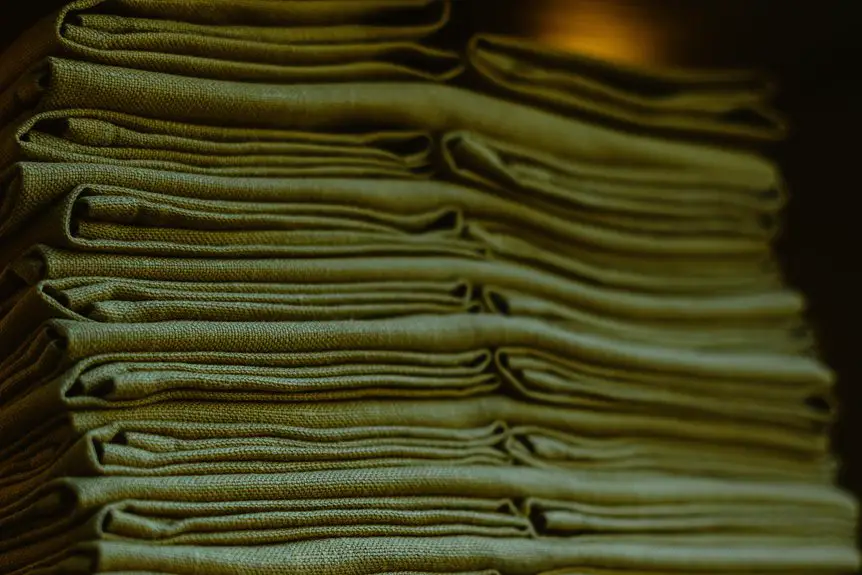If you want a fabric that’s durable, wrinkle-resistant, and easy to care for, polycotton—usually a 65/35 polyester-cotton mix—offers a smooth feel that holds color and shape well. Cotton blends, however, vary widely by their secondary fibers, like spandex or rayon, providing stretch or softness but often needing gentler care. Polycotton dries quickly and resists fading, making it practical for everyday use. Keep going to discover which blend suits your lifestyle best.
Table of Contents
Key Takeaways
- Polycotton combines about 65% polyester and 35% cotton, offering durability and wrinkle resistance unlike varying cotton blends.
- Cotton blends mix cotton with fibers like spandex, rayon, or linen, providing unique textures and flexibility beyond polycotton’s smoothness.
- Polycotton dries faster, resists shrinking, and holds color longer compared to many cotton blends that may require delicate care.
- Cotton blends often enhance softness, stretch, or breathability depending on the secondary fiber, while polycotton prioritizes strength and easy maintenance.
- Understanding fabric composition helps choose between polycotton’s durability and cotton blends’ specialized feel and performance for specific uses.
What Is Polycotton Fabric?
Polycotton fabric combines the best qualities of polyester and cotton fibers. When you wear or use polycotton, you get the softness and breathability of cotton paired with polyester’s durability and resistance to wrinkles and shrinking.
This blend usually contains around 65% polyester and 35% cotton, but ratios can vary depending on the manufacturer. You’ll notice polycotton feels smoother than pure cotton and dries faster, making it ideal for everyday clothing and bedding.
It’s also less prone to fading and holds its shape well after multiple washes. If you want fabric that’s low-maintenance yet comfortable, polycotton is a smart choice.
It balances natural comfort with synthetic strength, offering you versatility and ease in fabric performance.
Exploring Different Types of Cotton Blends
When you choose cotton blends, you tap into a variety of fabric options that combine cotton with different fibers to enhance specific qualities.
For example, cotton-spandex blends add stretch, making your clothes more flexible and comfortable.
Cotton-rayon blends, on the other hand, offer a silky feel and better drape, perfect for stylish apparel.
You might also find cotton-linen blends, which bring breathability and a lightweight texture, ideal for warm weather.
Each blend offers unique benefits, letting you pick fabrics that suit your needs, whether it’s durability, softness, or moisture-wicking.
Exploring these blends helps you understand how cotton partners with other fibers to create fabrics with tailored performance and comfort, expanding your choices beyond pure cotton and simple polycotton mixes.
Key Characteristics of Polycotton vs. Cotton Blends
Although both fabric types combine cotton with other fibers, you’ll notice distinct differences between polycotton and various cotton blends regarding texture, durability, and care.
Polycotton typically feels smoother and more uniform due to its consistent cotton-to-polyester ratio, while cotton blends vary widely in feel depending on the secondary fiber involved.
When it comes to durability, polycotton resists wrinkles and shrinking better, making it easier for you to maintain. Cotton blends, on the other hand, might offer unique traits like extra softness or stretch, but they often require more delicate handling.
You’ll also find that polycotton dries faster and holds color longer. Understanding these characteristics helps you pick the right fabric for your specific needs without compromising on comfort or longevity.
Advantages of Choosing Polycotton
When you choose polycotton, you get a fabric that’s durable and strong enough to handle everyday wear.
You’ll also appreciate how easy it’s to care for, saving you time and effort.
Plus, polycotton offers great value by being cost-effective without sacrificing quality.
Durability and Strength
Because polycotton combines the best qualities of polyester and cotton, it offers superior durability and strength compared to pure cotton blends. When you choose polycotton, you’re investing in a fabric that can stand up to daily wear and tear without losing its shape or integrity.
Here’s why polycotton is tougher:
- Resists tearing and stretching – The polyester fibers add resilience, preventing fabric from easily ripping or deforming.
- Maintains strength after washing – Unlike pure cotton blends, polycotton holds up well after multiple washes, keeping its firmness intact.
- Handles heavy use – Whether for uniforms or upholstery, polycotton endures rigorous use without quickly degrading.
This means you get longer-lasting fabric that maintains both comfort and reliability.
Easy Care Benefits
Polycotton’s durability goes hand in hand with its easy care benefits, making it a practical choice for everyday use.
You’ll find it resists wrinkles better than pure cotton, so you spend less time ironing. It dries faster, which is perfect if you need your clothes or linens ready in a hurry.
Polycotton also holds its shape well after washing, so you won’t worry about shrinking or stretching out. Since it’s less prone to creasing, you can toss it in the washer and dryer without special treatment.
These qualities mean you can maintain a fresh, neat look with minimal effort, saving you time and hassle in your daily routine.
Choosing polycotton lets you enjoy both convenience and comfort effortlessly.
Cost-Effectiveness and Value
Choosing polycotton can save you money without sacrificing quality. This fabric blend combines the best of both worlds: the comfort of cotton and the durability of polyester.
When you choose polycotton, you get:
- Affordable Pricing – Polycotton is generally less expensive than 100% cotton fabrics, helping you stretch your budget.
- Long-Lasting Wear – It resists wrinkles and shrinking, so you won’t need to replace your items as often.
- Low Maintenance – Easy to wash and quick to dry, polycotton saves you time and energy costs.
How Cotton Blends Affect Fabric Performance
When you mix cotton with other fibers, the resulting fabric often performs quite differently than pure cotton.
Blending cotton with polyester, for example, boosts durability and wrinkle resistance, so your clothes stay crisp longer without frequent ironing. It also improves moisture-wicking, keeping you cooler and drier during physical activity.
Mixing cotton with polyester enhances durability, wrinkle resistance, and moisture-wicking for lasting comfort and freshness.
On the other hand, adding fibers like rayon can enhance softness and drape, giving the fabric a smoother feel and better flow. However, blends may affect breathability; some synthetic fibers reduce airflow compared to 100% cotton.
You’ll notice that blends often dry faster, making them practical for activewear or travel.
Ultimately, understanding these performance changes helps you pick fabrics that best suit your lifestyle and comfort needs.
Tips for Caring for Polycotton and Cotton Blend Fabrics
To keep your polycotton and cotton blend fabrics looking their best, you’ll want to follow proper washing guidelines and choose the right drying methods.
Ironing on the correct setting and storing them properly also makes a big difference in maintaining their quality.
Let’s go over these simple tips to help you care for your fabric blends effectively.
Washing Guidelines
Although polycotton and cotton blends share some care similarities, each fabric type demands specific washing techniques to maintain its quality.
To keep your garments looking fresh and lasting longer, follow these simple guidelines:
- Use cold or warm water: Hot water can damage polycotton fibers and shrink cotton blends. Stick to cooler temperatures to preserve fabric integrity.
- Choose a gentle detergent: Harsh chemicals can wear down fibers. Opt for mild detergents to protect the blend’s softness and color.
- Avoid bleach and fabric softeners: These can weaken fibers and reduce fabric lifespan, especially in polycotton. Instead, use natural alternatives or skip them entirely.
Drying Recommendations
Since improper drying can damage both polycotton and cotton blend fabrics, you should handle this step carefully to maintain their durability and appearance.
For both fabrics, it’s best to use a low heat setting if you opt for machine drying. High heat can cause shrinkage or weaken fibers over time.
If possible, air drying is ideal—just lay the fabric flat or hang it to avoid stretching.
When using the dryer, remove items promptly to prevent wrinkles and reduce the need for excessive ironing.
Avoid overloading the dryer, as this can increase drying time and stress the fabric.
Ironing and Storage
When you iron polycotton and cotton blend fabrics, using the right temperature setting is essential to prevent damage. Set your iron to a medium heat, and always test on a small, hidden area first.
Avoid using steam on polycotton as it can cause water spots.
For proper storage, keep these tips in mind:
- Fold clothes neatly to minimize wrinkles and avoid stretching the fibers.
- Store in a cool, dry place away from direct sunlight to prevent fading.
- Use breathable garment bags for long-term storage to maintain fabric freshness.
Frequently Asked Questions
Can Polycotton Fabrics Be Recycled?
You can recycle polycotton fabrics, but it’s tricky because they combine synthetic and natural fibers. You’ll need specialized facilities to separate them, so check local recycling options or consider donating to extend their life instead.
Are Polycotton Fabrics Hypoallergenic?
Think of polycotton as a gentle breeze—mostly soft but with synthetic whispers. You won’t find it truly hypoallergenic; it might irritate sensitive skin, so you’ll want to test before trusting it as your cozy choice.
How Do Polycotton Fabrics Impact the Environment?
You’ll find polycotton uses less water than pure cotton but still involves synthetic fibers, which can shed microplastics. So, while it’s more eco-friendly in some ways, it still impacts the environment negatively.
Can Polycotton Be Used for Upholstery?
You might think polycotton isn’t durable enough for upholstery, but it actually holds up well and resists wrinkles. You’ll find it comfortable, affordable, and easy to clean, making it a practical choice for your furniture.
What Is the Cost Difference Between Polycotton and Pure Cotton?
You’ll find polycotton usually costs less than pure cotton because it blends synthetic fibers with cotton. It’s more affordable, durable, and wrinkle-resistant, while pure cotton tends to be pricier but softer and more breathable.







